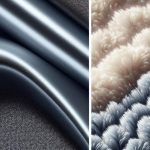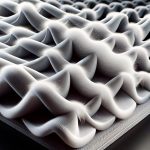If you're searching for fabrics that capture the sleek, modern look of nylon, you're in luck. Several versatile options offer the same aesthetic appeal with their own distinct advantages.
From the flexibility of polyester to the smoothness of spandex, these fabrics provide an array of choices for your projects.
Microfiber boasts a soft touch and durability, while rayon offers a lightweight, breathable feel. For those seeking sustainable alternatives, polypropylene delivers both eco-friendliness and style.
Whether you're aiming for sporty activewear or chic everyday attire, these five fabrics mimic the appearance of nylon while offering a range of desirable properties to elevate your creations.
Key Takeaways
- Polyester is a versatile and durable alternative to nylon, with exceptional durability, resistance to stretching and shrinking, and quick-drying properties.
- Spandex is another option that mimics the look and feel of nylon, offering remarkable elasticity, form-fitting garments, and a sleek appearance.
- Microfiber, a synthetic blend of polyester and polyamide, is soft, lightweight, and moisture-wicking, making it ideal for activewear and linens.
- Rayon, a lightweight fabric with a silk-like appearance and texture, is breathable, moisture-wicking, and suitable for activewear and everyday clothing.
Polyester: A Versatile Alternative
Polyester offers a versatile and practical alternative to nylon. When compared to nylon, polyester has several benefits that make it an appealing choice for various applications.
Polyester is known for its exceptional durability, making it resistant to stretching and shrinking. This characteristic allows polyester fabrics to maintain their shape and size even after multiple washes, unlike nylon, which may stretch out over time.
Additionally, polyester is less prone to wrinkling, making it an excellent option for travel and everyday wear. Its quick-drying properties also set it apart from nylon, making it a preferred choice for activewear and outdoor gear.
Moreover, polyester is often more affordable than nylon, providing a cost-effective option without compromising on quality. Its versatility extends to its ability to mimic the look and feel of nylon, making it a popular choice for those seeking the aesthetic of nylon without the associated costs.
Spandex: Stretchy and Sleek
Looking for a fabric that offers exceptional stretch and a sleek appearance? Look no further than spandex. This innovative material is renowned for its remarkable elasticity, making it a top choice for creating stretchy textiles with a sleek, form-fitting look.
Spandex, also known as elastane, is a synthetic fiber that can stretch up to 600% of its original size. This exceptional stretch makes it an ideal choice for athletic wear, dance costumes, and form-fitting clothing.
Spandex is often blended with other fabrics such as polyester or nylon to enhance its durability and resilience. The combination of spandex with sleek materials creates garments that not only offer a comfortable stretch but also maintain a smooth, streamlined appearance. This blend is particularly popular in activewear and body-hugging apparel, providing wearers with both flexibility and a polished silhouette.
When shopping for stretchy and sleek fabrics, keep an eye out for spandex blends. Whether you're seeking form-fitting workout gear or stylish, body-skimming attire, garments made with spandex are sure to provide the flexibility and sleek look you desire.
Microfiber: Soft and Durable
For sleek and form-fitting garments that mimic the look of nylon, consider microfiber, a soft and durable fabric that offers both comfort and resilience. Microfiber is a synthetic blend of polyester and polyamide that is known for its exceptional softness, lightweight nature, and durability. It is a popular choice for activewear, intimate apparel, and various types of linens due to its ability to wick moisture away from the body while providing a gentle feel against the skin.
When it comes to microfiber, its benefits and maintenance tips are essential to consider. Below is a table summarizing the key advantages and care tips for microfiber fabric:
| Microfiber Benefits | Maintenance Tips |
|---|---|
| Softness and Comfort | Machine wash in cold water |
| Durability and Resilience | Avoid fabric softeners |
| Moisture-Wicking | Tumble dry on low heat |
Rayon: Lightweight and Breathable
To achieve the sleek and form-fitting look of nylon, consider rayon, a lightweight and breathable fabric that offers versatility and comfort. Rayon, known for its silk-like appearance and texture, can be a great alternative to nylon. It's made from natural fibers, giving it a soft and smooth feel against the skin. The benefits of rayon include its moisture-wicking properties, making it an excellent choice for activewear and everyday clothing. Additionally, rayon is highly breathable, allowing air to circulate and keeping you cool in warm weather.
- Rayon benefits:
- Soft and smooth texture
- Moisture-wicking properties
- Breathable and lightweight
Despite its many benefits, it's essential to consider the environmental impact of rayon production. While rayon is derived from natural fibers, the manufacturing process often involves the use of chemicals and large amounts of water. As a conscious consumer, it's important to look for sustainably produced rayon or consider eco-friendly alternatives. By understanding the benefits and environmental impact of rayon, you can make informed choices when incorporating this fabric into your wardrobe.
Polypropylene: Sustainable and Stylish
Consider polypropylene as a sustainable and stylish alternative to rayon for achieving the sleek and form-fitting look of nylon. Polypropylene is a versatile and eco-friendly material that offers a range of benefits, making it an excellent choice for sustainable fashion. Innovative weaving techniques have enabled polypropylene to mimic the appearance and texture of nylon while remaining environmentally conscious.
| Polypropylene Benefits | Innovative Weaving Techniques |
|---|---|
| Lightweight and durable | Advanced 3D knitting technology |
| Moisture-wicking properties | Seamless construction for a sleek look |
| Recyclable and low environmental impact | Textured finishes for a nylon-like appearance |
Polypropylene's lightweight and durable nature make it suitable for activewear and everyday apparel. Its moisture-wicking properties help keep the body dry and comfortable. Additionally, polypropylene is recyclable and has a low environmental impact compared to other synthetic materials. Advanced 3D knitting technology and seamless construction techniques allow for form-fitting styles, while textured finishes replicate the look of nylon. Embracing polypropylene in fashion not only offers a stylish aesthetic but also aligns with sustainable and responsible clothing choices.
Frequently Asked Questions
What Are the Specific Care Instructions for Maintaining the Appearance of Fabrics That Mimic the Look of Nylon?
To maintain the appearance of fabrics that mimic the look of nylon, follow specific care instructions. Proper fabric maintenance involves gentle washing, avoiding heat, and using mild detergent. Air-dry to preserve the fabric's appearance and longevity.
Are There Any Potential Environmental Impacts Associated With the Production and Disposal of These Nylon-Mimicking Fabrics?
The production and disposal of fabrics mimicking nylon can have significant environmental impact, contributing to plastic pollution and resource depletion. Sustainable alternatives like recycled polyester and bio-based materials offer a more eco-friendly choice.
Can These Fabrics Be Used for Outdoor or Athletic Wear, and if So, What Are Their Performance Capabilities in These Environments?
You can use these fabrics for outdoor or athletic wear. They offer performance benefits like durability, moisture wicking, and breathability. Plus, they're produced sustainably and ethically, making them a great choice for environmentally conscious consumers.
Are There Any Specific Dyeing or Printing Techniques That Work Particularly Well With These Fabrics to Achieve Vibrant Colors and Patterns?
When dyeing fabrics that mimic the look of nylon, consider using disperse dyes and sublimation printing techniques for vibrant colors and patterns. These methods work exceptionally well to achieve the desired results on such fabrics.
How Do the Prices of These Nylon-Mimicking Fabrics Compare to Traditional Nylon Fabrics, and Are There Any Cost-Saving Benefits to Using Them?
When comparing prices, nylon-mimicking fabrics often offer cost-saving benefits over traditional nylon. Additionally, they provide durability benefits, making them a practical choice. Understanding the cost comparison and durability benefits can guide your decision-making process.
- How Does Ring Spun Cotton Affect Garment Fit and Shape Retention? - August 13, 2024
- What Are the Challenges in Producing Ring Spun Cotton? - August 13, 2024
- Is Ring Spun Cotton Suitable for Plus-Size Clothing? - August 13, 2024






